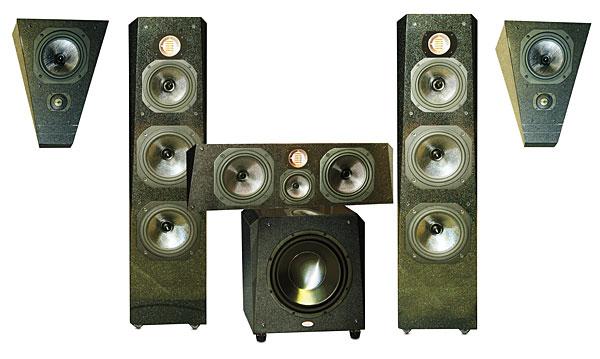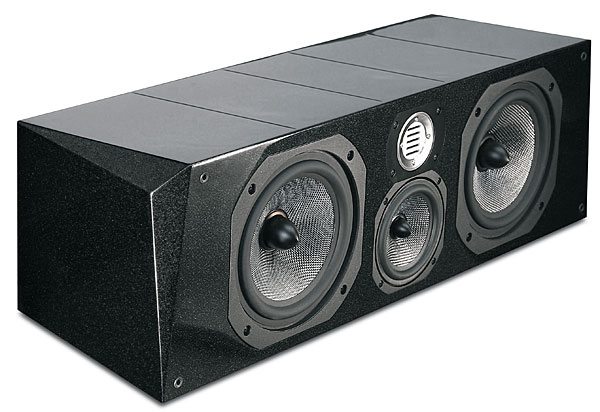Legacy Audio Classic HD Speaker System

At A Glance: Folded-planar magnetic tweeters • Treble and bass trim switches • Biwire and biamp capable
Every company has its genesis story, be it the back of a napkin or something more grandiose. Apple, of course, is famous for starting out in Steve Jobs’s parents’ garage. Lutron’s backstory isn’t quite as well known, but its unassuming beginnings were in the bedroom founder Joel Spira and his wife intended to use as their first child’s nursery. (“Sorry, kid, you’ll have to sleep on the couch. Daddy’s got a solid-state dimmer to invent.”) Similar to Apple, Legacy Audio’s birthplace was in a garage; but this garage was far from Cupertino. Instead, it was located in the midst of the cornfield-filled upper Midwest where, according to Legacy, Bill Dudleston and “a stubborn Dutch craftsman,” Jacob Albright, built the company’s first speaker, the Legacy-1, in 1983. Thirty years later, though, what the heck does any of this have to do with Legacy Audio’s loudspeakers today? Really, who gives a flying flip about two dudes, a garage, cornfields, and some woodworking equipment? (Hmm…cornfields. Wasn’t there a movie about that? “If you build it, they will listen.”)
Sometimes these tales are semi-legendary for the inspiring dichotomy of a behemoth enterprise arising out of somebody’s basement or toolshed. In other cases, the stories give a glimpse of the ethos within the company. I bring up Legacy’s stubborn Dutch craftsman bit because it’s obvious from the first look at any Legacy Audio speaker that a great deal of attention was paid to the design, fit, and finish of the cabinetry. Of course, the ongoing trend in speaker design at the moment is to make the cabinets as narrow and as small as possible; but a quick glance at Legacy’s 74.5-inch-tall, 320pound, 10-driver Helix speaker gives a pretty good clue that Dudleston never got the memo about putting speakers on the Slim-Fast diet. (Legacy does make an LCR soundbar—called, creatively, the Soundbar—but, although it’s only 8.5 inches tall and 5.25 inches deep, it’s a whopping 71.5 inches wide.) Rather than attempting to minimize the speakers’ visual footprint by wrapping them in cloth or shaping the sides of the cabinets to give the optical illusion that they are smaller than they really are, Legacy actually embraces— or, dare I say, revels in—large, authoritative drivers and full-bodied cabinets in which to mount them.
So, if you’re looking for something petite to hang on the wall or hide in a cabinet—or something that minimizes the number of boxes in the room by simulating the presence of surround speakers—you’re not going to find anything even remotely resembling that type of product here. But, if you’re willing to dedicate some floor space in trade for some spacious sound, read on.
A Classy Classic
Although it was disappointing to my ears, my back was happy that Legacy didn’t send a pair of the Helix speakers for this review. Instead, what arrived was a pair of the company’s second-smallest tower speaker, the Classic HD, along with a Silverscreen HD center channel, a pair of the artful Deco on-wall surround speakers, and a Metro subwoofer. No lightweights themselves, the Classic HDs weigh a healthy 110 pounds each and stand 44 inches tall. Like a plus-size model on a Parisian catwalk, though, the Classic HDs are in no way reticent about strutting their stuff because in their case, big is definitely beautiful. For starters, the Classic HD’s cabinet is sculpted along the top and partway down the front baffle as if the corners of the cabinet were carefully melted away. The versions I received came in a beautiful black pearl with subtle, sparkly flecks that seem to float just beneath the polished gloss finish. In fact, this was the finish for each speaker in the system.

Behind the Classic HD’s grille are a pair of 8-inch bass drivers, a single 7-inch midrange driver featuring a Rohacell-reinforced, silver-graphite-skinned cone, and a 1-inch folded-Kapton-diaphragm tweeter. Although it sounds like something out of The Lord of the Rings, Rohacell is a low-density, 100-percent closed-cell foam material that works as a super-light structure upon which to adhere the interwoven silver and graphite. Dudleston says he uses the silver-graphite combination because the carbon-graphite fibers and the silver fibers have different characteristics that he believes work to smooth out peaks and dips in the driver’s output. Hidden behind the driver’s phase plug is an additional magnetic circuit that provides a “reversion field.” In addition to reducing non-linearities in the driver’s performance, Dudleston explains, it also increases efficiency and extends the frequency range.
Legacy’s folded-diaphragm tweeter, which is used in the front main and center speakers (along with a circular variant in the surround speakers), is based on the same decades-old Heil Air Motion Transformer technology that has been gaining in popularity in recent years—most prominently in speakers from GoldenEar Technology and MartinLogan—as improvements in materials and manufacturing have resulted in higher performance and increased reliability. Essentially, it uses a pleated diaphragm material (in Legacy’s case, Kapton) to which conductive traces are attached. When the audio signal is applied, the pleats are pulled apart and pushed together rapidly to squeeze air, compressing and rarefying it, sending sound into the room. You can think of it as being a little accordion sitting behind the grille, except without the Cajun music.

Home theARTer
In terms of size, the Silverscreen HD center channel may be the most problematic speaker in the system because, well, at 32 inches wide and 10 inches in both depth and height, this one’s pretty big relative to most other center-channel speakers. But you
can understand (and appreciate) the large cabinet when you hear the performance of the Silverscreen HD’s two 8-inch woofers along with a 5.25-inch midrange and 1-inch ribbon tweeter. (It
also employs a PDH—Pretty Damn Heavy—design of 45 pounds.) Both the Silverscreen HD and the Classic HD include a terminal plate on the rear of each speaker containing two rows of jumpered five-way binding posts that allow the speakers to be biamped or biwired. The terminal plate also includes two toggle switches. The Treble Trim switch toggles between flat and –2 decibels at 10 kilohertz; and the Bass Trim switch adjusts the bass output from flat to 2 dB down at 60 hertz—a setting that also raises the speaker’s nominal 4-ohm impedance for amplifiers that can’t comfortably handle the
load. Since my listening room
is not overly bright and I was using an Anthem MCA 50 for amplification, I preferred the toggle switches in their flat positions.
In a sense, the speaker I am most fond of in this system is the on-wall Deco. It’s aptly named because its downward-sloping, trapezoidal appearance is evocative of a lighting sconce that might have been seen in an Art Deo–styled theater of the 1920s or 1930s. As a matter of fact, Legacy even offers a light puck that can be placed on the broad, flat top of the Deco—allowing it to do double duty as both a decorative light sconce and a surround speaker. In addition to a small port opening, the speaker’s single pair of binding posts is also located on the top of the speaker. This placement keeps the connectors hidden from view while keeping them easily accessible from an installation standpoint, especially if the speaker wires are not being run inside the wall behind the speaker. Underneath the mostly triangular grille is one of the same 8-inch woofers found in the Classic HDs and Silverscreen HD. While the tweeter in the Deco is also a planar magnetic design, this particular incarnation uses a circular Kapton diaphragm with a spiral conductor.






























































